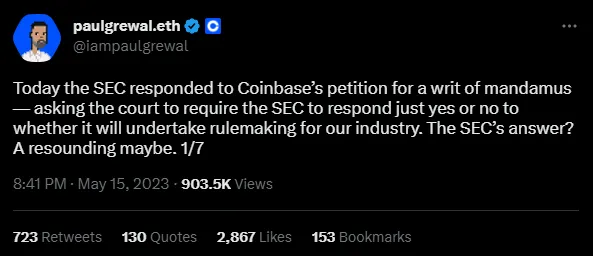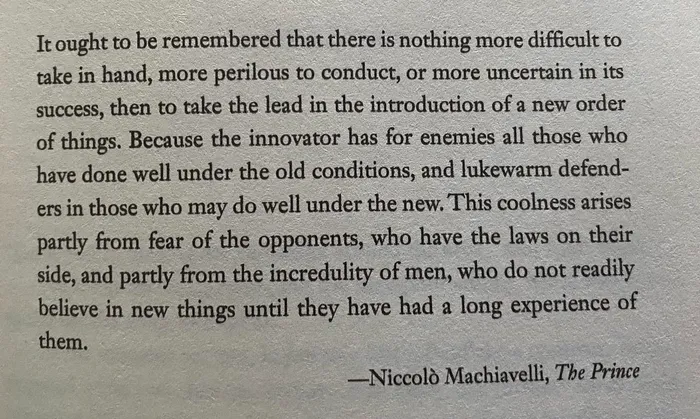“Psyops” is a word that gets thrown around a lot on CT — sometimes accurately, most times not.
Do Kwon’s infamous “steady lads” was pure psyops. Random Twtrr anons fudding [insert: ur fav internet money security coin] is not.

Psyops is short for psychological operations. And at its core, it refers to the deliberate attempt to influence the emotions, motives, objective reasoning, and, ultimately, the behavior of governments, organizations, or individuals.

These operations are commonly employed by militaries, intelligence agencies, governments, and companies for various purposes, such as deception, influencing public opinion, or promoting specific agendas.

A bloke by the name of Edward Bernays (1891-1995) was one of the world’s first psyops practitioners.

Bernays is considered the father of the modern U.S. media machine. He believed that individuals could be influenced and guided through subconscious desires and motivations. Drawing on his uncle Sigmund Freud’s theories, Bernays recognized the power of appealing to emotions, instincts, and unconscious desires to manipulate public opinion. He called this approach “engineering consent.”
Quick aside — the line between psyops, propaganda and media is, uh, blurry. They’re all in the influence game. Where exactly “influence” crosses the line into “psyops” is, well, unclear…

In 1925, Mr. Edward Bernays published a short book called Propaganda, which applied the lessons of WWI for the purpose of “regimenting the public mind every bit as much as an army regiments their bodies.”

Disclaimer: I haven’t read this book yet. But I did just order it. Thx Jeff Bezos!
Here are a few, uh, feel good quotes from da book:
“With the printing press and the newspaper, the railroad, the telephone, telegraph, radio and airplanes, ideas can be spread rapidly and even instantaneously over the whole of America. …Instead of a mind, [print and] universal literacy has given the man rubber stamps, rubber stamps inked with advertising slogans, with editorials, with published scientific data, with the trivialities of the tabloids and the platitudes of history, but quite innocent of original thought. Each man’s rubber stamps are the duplicates of millions of others.”
“There are invisible rulers who control the destinies of millions. It is not generally realized to what extent the words and actions of our most influential public men are dictated by shrewd persons operating behind the scenes. Nor, what is still more important, the extent to which our thoughts and habits are modified by authorities..…No serious sociologist any longer believes that the voice of the people expresses any divine or specially wise and lofty idea. The voice of the people expresses the mind of the people, and that mind is made up for it by the group leaders.”

“Invisible rulers who control the destinies of millions” — Bing Creator
Other well-known campaigns of Bernays include a 1929 effort to promote female smoking by branding cigarettes as feminist “Torches of Freedom” and his work for the United Fruit Company in the 1950s, connected with the CIA-orchestrated overthrow of the democratically elected Guatemalan government in 1954.

Edward Bernays 1929 “Torches of Freedom” campaign for the American Tobacco Company raised women’s purchases of cigarettes in the U.S. from 5% to 33% percent and was eagerly embraced by feminist leaders
There are many other famous and interesting cases of psyops. Here are a few historical examples:
The Trojan Horse: One of the earliest and simplest examples of psyops occurred over 3,000 years ago in the Trojan War. In a bid to end the war, the Greeks pretended to sail away, leaving a giant wooden horse as an offering to the goddess Athena. The Trojans, believing themselves to have finally won the battle, took the horse into Troy as a victory trophy. However, the horse was hollow and contained a group of Greek soldiers who emerged at night and opened the gates for the rest of the Greek army, who had returned under cover of darkness. The Greeks then sacked Troy and ended the war.

“The Trojan Horse, cypherpunk aesthetic” — Bing Creator
Operation Mincemeat: During World War II, the British intelligence agency MI5 carried out Operation Mincemeat, a deception campaign aimed at fooling the Axis powers about the Allies’ invasion plans. They planted false documents on a corpse, which was released into the sea near Spain. The documents indicated that the Allies were planning to attack Greece instead of Sicily, diverting enemy attention and resources. I highly recommend the book “Operation Mincemeat” by Ben Macintyre; it reads like fiction.

Adm. John Godfrey, the British director of naval intelligence, crafted the idea for Operation Mincemeat with the help of Lt. Cmdr. Ian Fleming. When Fleming went on to create the world of James Bond, it was rumored that the character “M” was based on Godfrey.
The Ghost Army: Also during World War II, the U.S. Army created a special unit called the 23rd Headquarters Special Troops, also known as the Ghost Army. Its mission was to deceive the German forces by creating fake radio traffic, sound effects, inflatable tanks and vehicles, dummy airfields and camps, and impersonating other units. The Ghost Army operated in France, Belgium, Luxembourg, and Germany, creating illusions of large Allied forces where there were none or diverting attention from real movements and attacks. The Ghost Army is credited with saving thousands of lives and contributing to several Allied victories.

Radio Free Europe: During the Cold War, Radio Free Europe was established as a psyop tool by the United States to broadcast pro-Western news and information to countries behind the Iron Curtain. It aimed to counter Soviet propaganda and influence public opinion in Eastern European countries.

Operation Desert Storm: During the Gulf War of 1991, the U.S.-led coalition conducted a massive psyop campaign against Iraq’s military and civilian population. The campaign included dropping millions of leaflets over Iraq with messages such as “Saddam has lied to you” or “You are surrounded,” broadcasting radio programs that urged Iraqi soldiers to surrender or defect, using loudspeakers to play Islamic prayers or eerie sounds near Iraqi positions, and deploying special forces teams to spread rumors and misinformation among Iraqi troops. The campaign also exploited Iraq’s poor communication system by sending false orders or reports to confuse and demoralize Iraqi commanders. The campaign was extremely effective in undermining Iraq’s will to fight.

Close to 500,000 of these leaflets were dropped by U.S. Army Civil Affairs and Psychological Operations Command during Operation Desert Storm in 1991. The front of the leaflet (above) shows a B-52 bomber dropping bombs with the Arabic text that translates to “This is your first and last warning! The 16th Infantry Division will be bombed tomorrow! Flee this location now!” The back of the leaflet (below) translates to “The 16th Infantry Division will be bombed tomorrow. The bombing will be heavy. If you want to save yourself, leave your location and do not allow anyone to stop you. Save yourself and head toward the Saudi border, where you will be welcomed as a brother.”
Fast forward to today, and psyops is still being utilized by militaries, governments and media.

Some of the most interesting modern-day psyops are occurring in Ukraine.

A destroyed Russian tank in the Kharkiv region. Photo by Iryna Rybakova, a Ukrainian press officer
Amid the first state-on-state war in the age of social media, much of the psyops are aimed at manipulating public opinion.
Per U.S. intelligence, prior to its invasion, Russia planned to stage “false flag” attacks and killings of ethnic Russians and Russian speakers in Ukraine and blame them on Ukrainian forces or nationalist groups. Russia hoped these incidents would create a narrative of genocide and persecution that would help mobilize support for its “special military operation.”

Russia’s pre-war psyops failed to fool the Ukrainians or Americans — but they did fool the Russian army.

The Russian army was drinking so much of their own Kool-Aid they actually packed parade uniforms for the invasion of Ukraine. Ukrainian officials say the Russian soldiers were convinced they’d take Kyiv in two days and believed they would be greeted as liberators by the Ukrainian people.

Putin sits far removed from his top generals… and reality
The Ukrainians have proved more adept at psyops. In the war’s early days, much of the world expected Kyiv to fold. The U.S. famously offered to evacuate President Zelensky, to which he responded by saying: “I need ammunition, not a ride.” That single line became a rallying cry for the entire country and immediately cemented Mr. Zelensky as a Churchillian leader.

The experience proved to the Ukrainians that they could rally the world behind their bravery.

Kyiv went on to leverage this same playbook when they valorized the story of a brave Ukrainian soldier — surrounded on a small island by Russian warships — saying, “Russian warship, go fvck yourself!” It was, reportedly, the last communication heard over the radio before the soldier was killed. The slogan immediately went viral and become an enduring symbol of Ukranian resistance. The image was even turned into a postage stamp.

Weeks later, Ukraine quietly admitted the solider in question was not only alive but had been freed in a prison swap with Russia.

Whether the whole story of his valiant death was purposefully concocted or not was left unsaid.

The weight of a nation — Valerii Zaluzhnyi, Commander-in-Chief of the Armed Forces of Ukraine
Perhaps the most interesting use of psyops is related to Ukraine’s future, err, imminent, err, current counteroffensive.

The Ukrainians have been saying the counteroffensive is here for months now. The Russians, fearing a looming assault, have rushed unprepared and ill-equipped troops to the frontlines. Each day the Russians wait on a knife’s edge for a coming counteroffensive that still has not yet materialized. This stalling tactic is purposeful.

Part of the counteroffensive psychology is to make the Russians believe it’s imminent for as long as possible. Every day that passes leads to more and more speculation, leading to anxiety among the Russian ranks.

Each day the Russians wait, the more frayed their nerves become. Some soldiers may not be able to take the waiting game and lose focus. This is what Ukraine is betting on: attrition. After all, it’s a war of attrition.

By endlessly delaying its counteroffensive, Ukraine is using psyops to degrade Russian forces before they fire their first missile in the ~coming~ counteroffensive.

Putin looks… tired
To close the loop — similar to Russia x Ukraine, crypto is also at war and is experiencing a sophisticated psyops campaign intended to confuse, degrade and demoralize its netizens.
I am, of course, referring to the statements and actions of this guy.

Gary Gensler’s engagement with crypto can be summed up in one word: silence.

On one hand, Gary said a lot when he taught classes at MIT on Blockchain and Money:
-
“Bitcoin is a new and powerful technology that has the potential to revolutionize the way we think about money and finance.”
-
“Blockchain technology is a distributed ledger that can be used to record transactions in a secure and transparent way. This could have a major impact on the way we do business.”
-
“Cryptocurrencies could make it easier for people to send and receive money across borders, and they could also make it easier for people to access financial services.”
-
“Cryptocurrencies are still a new and emerging technology, but they have the potential to change the world.”

However, on the other hand, Mr. Gensler’s time as SEC chair has been characterized by a lack of any and all regulatory clarity.

He has refused to say whether the SEC sees ether as a security, which diverges from the guidance of his predecessor, who stated that ETH should be classified as a commodity as it was “sufficiently decentralized.” Gensler has also sought to link the recent banking turmoil to the crypto industry, saying that three of the four big bank failures “had significant crypto books.”
So, why would a guy who is clearly highly intelligent, ambitious, and deeply understands crypto offer so little guidance?

Well, one explanation — that looks increasingly likely — is Gensler’s trying to confuse and demoralize the crypto community through misdirection and inaction. It’s the exact same psyops the Ukrainians are using against the Russians.

By saying nothing, Gensler paralyzes the crypto space. Entrepreneurs don’t know the rules. And crypto lawyers don’t know how to advise entrepreneurs on rules that don’t exist. Silence, inaction and opacity result in industry-wide paralysis, which is probably seen as a good thang in Gensler’s eyes.

Also, similar to Ukraine’s perpetually-around-the-corner counteroffensive, doing nothing costs zero dollars and zero resources. It’s free, baby free! If Gensler and the SEC were to issue real guidance or — imagine this! — create new rules and regulations, that would open them up to lawsuits and annoying litigation. Much easier to do nothing and psyop the degens through silence.

Perhaps Goldman Gary is a Simon & Garfunkel stan
Thus far, Gensler’s psyops campaign has been remarkably effective.

Trading has moved overseas.

And entrepreneurs have left for more hospitable shores.

The crypto industry must regain the initiative. We cannot afford to sit back and be complacent — that plays directly into Gensler’s hands. We must draw Gensler and the SEC outta their psyops routines and into the arena of ideas.

Our ideas are better than theirs; it’s time we prove it.
